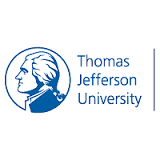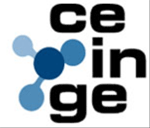Research topics
TEMPLE UNIVERSITY E THOMAS JEFFERSON UNIVERSITY of PHILADELPHIA, USA in the laboratory of Prof. Antonio Giordano (1993-1996)


1-Identification and characterization of the tumor suppressor gene Rb2/p130
He gave an essential contribution to the identification of the tumor suppressor gene Rb2/p130, to its chromosomal mapping in human, to the characterization of its genomic structure and on to the cloning of the murine homologous gene. All these data show the close analogy of sequence of Rb2/p130 with the retinoblastoma’s gene and with its homologous p107, especially in one region called “pocket”. Thanks to this “discovery”, today we can talk about the family of the retinoblastoma genes. Moreover, the complete genomic structure of Rb2/p130, as all the other data necessary to amplify exons of the gene from the human genomic DNA, are part of a patent of the United States of America. The objective of this patent was that of eventually use such information for diagnostic and therapeutic purpose.
2-Contribution to the differential diagnosis and to the molecular mechanisms of pathogenesis of human mesotheliomas.
In this series of observations, the immunohistochemical expression of the genes of the family of the retinoblastoma in mesothelioma is characterized. Evidence shows the integration in the genome of the mesothelioma cells of the oncogenic virus SV-40 and the interaction that its protein product has with the proteins of retinoblastoma. From this observation a prototype of viral pathogenesis is postulated, at least for certain cases of mesothelioma.
3-Characterization of the prognostic value of the immunohistochemical expression of the genes involved in the regulation of the cell cycle progression, Rb2/p130, p53 – p21 – p27, in lung cancer in relation to the clinical and morphological parameters and coordinated with immunohistochemical data of cellular typing and proliferation:
In this series of works the prognostic value of the tumor suppressor gene p53 immunohistochemical expression is evaluated, and also of some proteins involved in the regulation of the cell cycle (Rb2/p130, p21, e p27) in wide cohorts of human lung tumors. These works include some of the first experimental evidences on the role of the regulators of the cell cycle in the pathogenesis and progression of lung cancer.
UNIVERSITA’ CAMPUS BIOMEDICO DI ROMA (1997-1999)

1-Creation of a new animal model of transneuronal degeneration in the central nervous system of newborn rats.
During the research carried out in the neuroscience lab of Campus Biomedico, he was interested in the development of the sensory system of the newborn rat, in particular in the effect of the neurotrophins in furthering the right formation of the circuitry of the brain. He characterized from a structural and functional point of view a new animal model of trans-neuronal degeneration in the central nervous system of the newborn rats, identifying a group of cells (thalamo-cortical neurons) that need an exact sensory input from the periphery for their survival during the first days of their lives.
2-Contribution to the characterization of the genetic mutations responsible for child autism.
During the research carried on in the neuroscience lab of Campus Biomedico, he collaborated in some genetic studies on child autism, outlining experimental procedures for the identification of some molecular alterations involved in this pathology.
ISTITUTO DEI TUMORI REGINA ELENA DI ROMA (2000-2004)

Studies on cutaneous melanoma:
In this period he started to be interested in cutaneous melanoma, improving a procedure to find micrometastases in the peripheral blood through RT-PCR for the tyrosinase encoding gene. Moreover, he studied the possible prognostic value of the expression of the transcription factor AP-2 and of the apoptotic mediator APAF-1 in cutaneous melanoma. Finally, he characterized some of the molecular pathways responsible for the neoplastic progression of melanoma in an in vitro system, using the cDNA array’s technology.
SECONDA UNIVERSITA’ DI NAPOLI (2001-attualmente)

1-Role of the myocardial apoptosis in the ventricular remodeling post myocardial infarction.
He has coordinated for several years a multi-institutional research group for the study of myocardial apoptosis phenomena during the ventricular remodeling post myocardial infarction. Such studies have contributed to define the pathophysiological mechanisms of the heart failure after a myocardial infarction and they brought to possible findings of therapeutic targets. The results obtained are recognized and mentioned in the most important international scientific texts of cardiology.
2-Analysis of the mediators of the cell cycle in human mesothelioma, in lung tumors and in thymoma.
He has coordinated for several years a multi-institutonal research group for the study of the mediators of the cell cycle in the pathogenesis and progression of human mesothelioma, of lung tumors and of thymoma. The results have been published in the most prestigious journals of oncology research.
3-Morphological and functional analysis of the serine protease HtrA1
He has been coordinating for many years a multi-institutonal and international research group for the study of the function of the serine protease HtrA1, an oncosoppressor-like gene involved in fundamental phenomena for cell growth and development. The research group led by Prof. Baldi is considered one of the world leaders in this specific research activity. The results have been published in the most prestigious journals of basic research and of oncology.
4-Contribution to the characterization of the genetic mutations responsible for the Bardet-Biedl syndrome and for the Duan syndrome.
Since 2000 he has been collaborating with Prof. Alessandro Iannaccone, Department of Ophthalmology, University of Tennessee Health Science Center, Memphis, in the collection and characterization of genetic material of families affected by Bardet-Biedl and Duan syndromes and in the study of genetic alterations responsible for these particular phenotypes. Recently, in two works, the first in collaboration with the Department of Pediatrics, Division of Medical Genetics and the Howard Hughes Medical Institute, University of Iowa, and the second one with the Department of Medicine, Harvard Medical School, Boston he has identified genes which mutations are responsible for these syndromes.
5-Studies of classical pathological anatomy
Based on the clinical activity carried out at the Anatomic Pathology Service, he developed different subject matters of classical pathological anatomy, especially for what concerns the description of rare cases of neoplastic, infectious and developmental disorders.
6-Definition of a model of digital filing for medical images and of a retrieval system, through CBIR technology.
He has been collaborating as scientific advisor with the “ACS” company of Rome, which has been engaged for several years in the transfer management technology of special images from satellites (in which it is recognized leader) in biomedical research. The result of this collaboration was the definition of a CBIR system for the filing and the consultation of dermoscopic images of pigmented skin lesions. Currently, further studies to apply such technology to other medical images are in progress.
FONDAZIONE ITALIANA ENDOMETRIOSI (2008-until now)

1-Studies on the pathogenesis of the endometriosis:
In this series of studies evidence in favor of an embryological origin of endometriosis are presented. In detail, it is proposed that endometriosis is caused by small molecular alterations during the embryogenesis of the female genital system, that bring to deficiency in the correct closure of the primordial uterine tube. Based on the observations on an original spontaneous animal model of endometriosis, it is also proposed as the initiating event, an altered oestrogen hormonal input to the fetus during one of the critical periods of embryogenesis. This experimental evidence has significantly contributed to the understanding of the pathogenesis of endometriosis (still unknown), and it’s obtaining recognition of the international scientific community.
2-Studies on the diagnosis and therapy of the endometriosis:
In this series of studies, through a proteomics approach, some proteins are identified, which differential expression in the peripheral blood of the patients with endometriosis has diagnostic value. Moreover, the AMH hormone (highly expressed in the endometriotic tissue) is introduced as a possible diagnostic marker to highlight the endometriosis lesions in vivo through techniques of imaging, and as a possible therapeutic target. These studies generated several patents for the definition of diagnostic and therapeutic kits for the endometriosis
STUDIES CONDUCTED AT BIOPULSE Srl (2009-until now)

He’s co-founder of the Biopulse Srl company, actively involved in the definition of new electro-medical products for the treatment of neoplastic diseases in the veterinary field. With dr. Spugnini, for several years he has been conducting a series of works on lab animals and on domestic animals for the characterization of the anatomo-clinical effects of the treatment with electrochemotherapy of experimental and spontaneous tumors. Such works have brought to the definition of new therapeutic oncologic protocols in pet animals. Finally, a new original electroporator (Onkodisruptor®) has been defined. This apparatus is actually in use in several research and clinical structures in USA and Canada
WORK AT CEINGE (2014-until now)

Since 2014 he directs the “core facility” of translational anatomic pathology at the CEINGE. The laboratory supplies services and performances pertaining to histological, cytology, histochemical, immunohistochemical and of molecular pathology techniques. The facility represents also, and mostly, a quality reference for researchers who want to characterize from a microscopic, histological and pathological point of view their animal models of human disease. The laboratory is also actively involved in a research project which the principle aim is to characterize the transcriptome and the metiloma in a group of breast cancer cases with the goal of identifying new molecular markers of diagnosis and prognosis in breast cancer.
